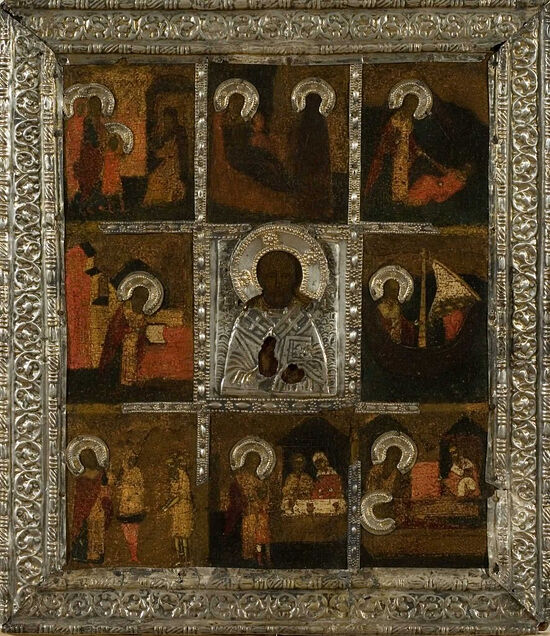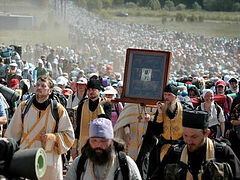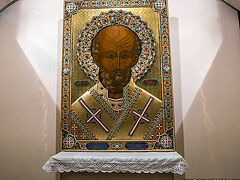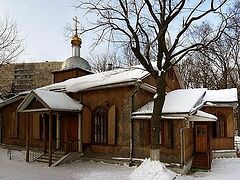Part 1: To the Velikaya River with St. Nicholas
Church Tradition tells the following about the appearance of the miracle-working icon of St. Nicholas on the banks of the Velikaya River: once, “a certain religious man… saw the radiance of luminous rays and was overwhelmed with the desire to come closer to its source. Сrossing himself, he made his way through a thicket and saw an icon of St. Nicholas perched beside a small spring; at the same moment, the mysterious light had disappeared.” The first miracle from the icon took place when a local peasant, a cripple, was healed as soon as he venerated it. A wooden chapel was soon built on the bank of the Velikaya River. The pilgrims from nearby villages and settlements flocked to venerate this holy place. The news about the miracles from the Velikoretsky icon soon reached the town of Khlynov, the capital of the Vyatka region. Sometime later, the clergymen and the city rulers in Khlynov decided to appeal to the residents of Velikoretsky villages asking them to move the miracle-working icon to Khlynov for safety and because there would be a “greater congregation of faithful.” Taking the icon away, the residents of Khlynov vowed to bring the icon of St. Nicholas back every year to the banks of the Velikaya River, the place of its glorious appearance. That’s how the ancient tradition of the Velikoretsky Procession was born.
In 1555, by the order of Tsar Ivan the Terrible and with the blessing of Metropolitan Macarius, the Velikoretsky icon made its first pilgrimage to Moscow. The Chronicle narrates: “And there went the icon of Nikola down the Vyatka and the Kama, then by the Volga up to Kazan and the city of Sviyazh, to Nizhny Novgorod by the Oka up to Kolomna, and from Kolomna up the Moscow River.” As was the custom then, the prominent local noblemen met the icon on its approach to the cities and towns, underscoring the solemnity of such an event. A boat transporting the icon sailed up the Moscow River to the Nikolo-Ugreshsky monastery, and by the Tsar’s order, it was met there by his brother, Prince Yury Vasilyevich and his entourage. The Sovereign of All Russia himself greeted it near the Simonov monastery with the boyars and the prominent Moscovites, as the chronicle narrates, “in great faith and ardent desire.” The hierarchs of the church and the council of clergymen welcomed the icon near the bridge over the Yauza River. The meeting was followed by a ceremonious procession. Metropolitan Macarius, the Primate of the Russian Church, welcomed the miracle-working icon by the Florovsky Gates of the Kremlin. It was triumphantly carried inside the Dormition Cathedral and “placed beside the Metropolitan’s throne,” where the metropolitan, in the presence of the Tsar and a great number of the Orthodox faithful, proceeded to hold a prayer service. “On the following day,” the Chronicle says, “inexhaustible miracles streamed from the icon of the great Wonderworker St. Nicholas in the church dedicated to the Most Pure One…”
Back then, Red Square was a massive construction site for a future cathedral of the Protection of the Mother of God on the Moat (St. Basil’s Cathedral). By the edict of the Tsar, one of its side chapels was consecrated to the Velikoretsky Icon of St. Nicholas. It is known that the procession of the cross from the Dormition Cathedral to the side chapel of “St. Nicholas the Velikoretsky on the Moat” was established then, and it was timed to coincide with July 29/ August 11, the feast of the Nativity of St. Nicholas the Wonderworker.
The icon’s return trip passed through Vologda. After the capture of Kazan, the Tatar hordes were scattered and took to the highway throughout Russia. To protect the miracle-working Velikoretsky Icon of St. Nicholas, the Tsar ordered that icon be concealed in Vologda. The miracle-working icon was buried in a mound of lime on the embankment next to the Ilyinsky monastery. It remained there while the residents defended their city. As soon as they routed the enemy, a letter was sent to the Tsar saying, “the Tatars were defeated near the city of Vologda by its residents with the intercession of the God-pleaser and wonderworker Nicholas.” Upon learning the news, the Tsar ordered that a copy be painted of the icon and installed in Vologda whereas the miracle-working Velikoretsky icon was allowed to depart back to Vyatka. The copy was painted, while at the icon’s hiding place, the city built a church to the Velikoretsky Icon of St. Nicholas the Wonderworker, known by the locals as “On the Lime.” Today it houses Vologda’s St. Alexander Nevsky Church.
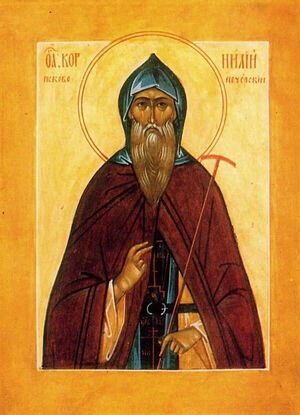 St. Cornelius of the Pskov Caves Monastery St. Cornelius of the Pskov Caves Monastery took one of the revered copies of the Velikoretsky icon with him. The icon granted healings among the monks of the monastery and the pilgrims. This icon is preserved in the Pskov Caves Monastery to this day under the name of, the “superior” icon (since it arrived in the monastery with St. Cornelius, the monastery superior). Another venerated copy of the Velikoretsky icon is located in the Ipatyevsky monastery in Kostroma. As early as 1556, Tsar Ivan the Terrible sent it there in remembrance of his slain son Ivan. The monasteries and the churches were consecrated in honor of the Velikoretsky icon. The holy relic arrived again in Moscow from Vyatka in 1614, when Rus’ was suffering the consequences of the Great Time of Troubles.
St. Cornelius of the Pskov Caves Monastery St. Cornelius of the Pskov Caves Monastery took one of the revered copies of the Velikoretsky icon with him. The icon granted healings among the monks of the monastery and the pilgrims. This icon is preserved in the Pskov Caves Monastery to this day under the name of, the “superior” icon (since it arrived in the monastery with St. Cornelius, the monastery superior). Another venerated copy of the Velikoretsky icon is located in the Ipatyevsky monastery in Kostroma. As early as 1556, Tsar Ivan the Terrible sent it there in remembrance of his slain son Ivan. The monasteries and the churches were consecrated in honor of the Velikoretsky icon. The holy relic arrived again in Moscow from Vyatka in 1614, when Rus’ was suffering the consequences of the Great Time of Troubles.
In 1668, by decree of His Eminence Alexander, the Archbishop of Vyatka and Velikaya Perm, May 24 / June 6 was designated the feast day of the appearance of the Velikoretsky icon of St. Nicholas. A special church service was compiled for services on that day. It remained in use until the beginning of the eighteenth century; undeservedly overlooked later, its hymns sounded again in 2000, the year of the 600th anniversary of the cross procession. Initially, the Velikoretsky Procession went along the Vyatka and the Velikaya Rivers, but in 1778, Bishop Lavrenty (Baranovich) of Vyatka issued a decree establishing a land route for the procession. Its route has remained unaltered ever since.
In the 1920s, the Cathedral Church in Vyatka, together with the miracle-working Velikoretsky icon, ended up in the hands of the Renovationists. In the early 1930s, the holy icon of the land of Russia disappeared. Only God knows where and when the icon vanished. It arrived mysteriously and left just as mysteriously, but the Russian people hope to see its return. Its disappearance was the reason why the processions terminated, but at the same time, another form of veneration had emerged: a pilgrimage. The faithful, following an ancient tradition, walked to the place of the appearance of the miracle-working icon carrying icons of St. Nicholas with them. During Khruschev’s persecutions, the pilgrimage to the Velikaya River was officially banned. The militia cordoned off the area, aiming to locate the pilgrims struggling through a thicket of wild forest, trying to reach the place of the icon’s appearance, and their goal was to take them away as far from the holy place as possible. The faithful had to walk the wooded trails at various times of the day, two or three at a time, to pass by unnoticed. It was owing to these people who remained faithful to God that the Velikoretsky Procession was preserved for future generations.
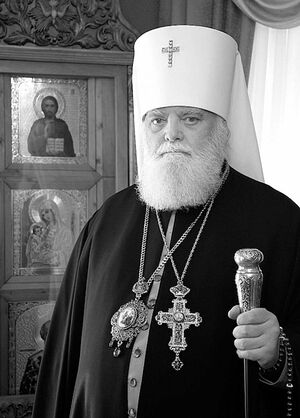 In 1978, Bishop Chrisanph (Chepil), Metropolitan of Vyatka and Sloboda of blessed memory, was appointed to head the Kirov Metropolia. He appealed to the local authorities, asking them to permit the procession of the cross and conduct the service at the riverbank of the Velikaya River. The service was allowed, but the procession wasn’t. The monastery dating back to the eighteenth to nineteenth centuries in the Velikoretskaya village was inaccessible for pilgrims—its buildings were lying in ruins and the churches closed. The liturgy on June 6 was served right on the bank of the river at a field church. It was to become a new tradition that exists to this day. Beginning from 1992, the procession was able to follow its historical route. In 2005, the Nikolo-Velikoretsky monastery was opened at the Velikoretskaya village. In 2000, His Holiness Patriarch Alexiy II, in his address on the occasion of the 600th anniversary of the procession of the cross, declared the appearance of the Velikoretsky Icon of St. Nicholas as an all-Russian feast day. In fact, we celebrate another anniversary this year: It was exactly 500 years ago when a precious riza was created for the original icon that has vanished.
In 1978, Bishop Chrisanph (Chepil), Metropolitan of Vyatka and Sloboda of blessed memory, was appointed to head the Kirov Metropolia. He appealed to the local authorities, asking them to permit the procession of the cross and conduct the service at the riverbank of the Velikaya River. The service was allowed, but the procession wasn’t. The monastery dating back to the eighteenth to nineteenth centuries in the Velikoretskaya village was inaccessible for pilgrims—its buildings were lying in ruins and the churches closed. The liturgy on June 6 was served right on the bank of the river at a field church. It was to become a new tradition that exists to this day. Beginning from 1992, the procession was able to follow its historical route. In 2005, the Nikolo-Velikoretsky monastery was opened at the Velikoretskaya village. In 2000, His Holiness Patriarch Alexiy II, in his address on the occasion of the 600th anniversary of the procession of the cross, declared the appearance of the Velikoretsky Icon of St. Nicholas as an all-Russian feast day. In fact, we celebrate another anniversary this year: It was exactly 500 years ago when a precious riza was created for the original icon that has vanished.

